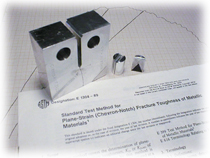
2061 So. 50 West
Bountiful, Ut. 84010
tel. 801-298-4899
fax 801-298-4875
dcicorp@xmission.com
 DCI corporation builds test systems and provides testing services based on ASTM standard E 1304, "Standard Test Method for Plane-Strain (Chevron-Notch) Fracture Toughness of Metallic Materials." This test method, commonly referred to as the Short Rod (SR) or Chevron Notch (CN) test method, was first proposed as a method of measuring plane-strain fracture toughness in 1976. It was accepted as an ASTM standard in 1989.
DCI corporation builds test systems and provides testing services based on ASTM standard E 1304, "Standard Test Method for Plane-Strain (Chevron-Notch) Fracture Toughness of Metallic Materials." This test method, commonly referred to as the Short Rod (SR) or Chevron Notch (CN) test method, was first proposed as a method of measuring plane-strain fracture toughness in 1976. It was accepted as an ASTM standard in 1989.
Advantages of E 1304 include:
- Substantially reduced costs for plane-strain fracture toughness testing.
- Fracture toughness can be measured on a wide variety of materials, including very brittle materials.
- Valid plane-strain fracture toughness values can be obtained on materials where inadequate material is available to obtain valid results by E 399.
- Fracture toughness values can be obtained at very specific locations in a structure.
- Values obtained are ASTM acceptable for plane-strain fracture toughness.
Two features of the Short Rod test make the advantages listed above possible.
Small Test Specimen Size The photograph above compares the size of a Compact Tension (CT) test specimen (E 399) with an equivalent sized Short Rod test specimen. The SR test specimen width (diameter) is half the width of the CT test specimen and only 3% of the volume. This small test specimen size can allow valid SR tests in cases where there may be inadequate material for a valid E 399 test. The small size allows fracture toughness to be pin-pointed at a specific location in a structure. The small amount of material required and simple test specimen geometry contribute to cost savings in fracture toughness testing.
No Fatigue Pre-Crack The design of the SR test specimen is such that a stable crack is generated in the test specimen without requiring a fatigue pre-crack procedure. This makes the test method applicable to a wide variety of materials. Very brittle materials such as ceramics and tungsten carbides, which are difficult or impossible to pre-crack, are tested easily with the SR test method, as are less brittle materials. Eliminating the need for fatigue pre-cracking greatly simplifies testing procedures, and reduces testing costs.